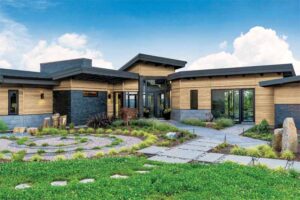
For building owners, designers, and architects who are looking to add another layer of artistry to their projects consider metal prints.
Metal prints and metal patterns—such as faux finish wood grain, patina, stone, Corten steel, or weathered rust—are popular examples. As uses for prepainted metal have diversified throughout the last few decades, coil-coated prints are a popular alternative to substrates such as wood and stone. The semi-transparent tinted coatings used to produce the metal pattern finish are engineered for weathering and longevity, enabling prepainted coil prints to maintain their visual appeal and structural integrity for years.
Visualizing the final product
While metal prints have been around for a long time, existing color offerings have been a consistent hurdle due to the keen eye and balance it takes to conceptualize how the layers of a print will ultimately look. Today the color and prints options have become much broader, and visualizing the layering and simultaneous contrast that happens when laying two colors on top of each other has become more attainable.
Lasting, durable impressions
The prints applied to coil-coated metal surfaces are designed to be durable and resistant to environmental factors such as UV radiation, moisture, infestation, and pollutants. This ensures the facade maintains its appearance over an extended period without fading or deteriorating.
Driving toward sustainability
The mimicking of natural prints on metal is a great alternative as the construction industry looks toward more sustainable building products and practices.
Aesthetic interest
In architectural design, prints can be a powerful tool to express the intended theme or concept of a building. Whether it is an historical motif, a futuristic pattern, or a cultural reference, prints can convey specific design narratives. Prints can add depth and visual interest to a building’s facade, allowing for intentional design like allowing a building to complement or contrast its surrounding area.
Customization and branding appeal
While common prints can include wood grain, stone texture, or geometric patterns, designers can dream up countless ideas or even use custom graphics. The prints and possibilities of today allow for creative minds to run wild. This is evidenced in newer trends such as oxidized metal looks or even ornamental perforations.
Conclusion
With the advances in technology and any number of prints and patterns to choose from, metal coating options seem endless. Designers and architects can look forward to envisioning even more creative projects.
Kiki Redhead is global CMF & trend manager for the Sherwin-Williams DesignHouse, and Brynn Wildenauer is architectural color designer for DesignHouse.


